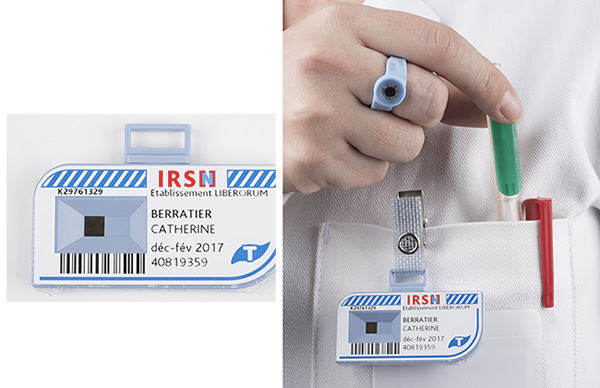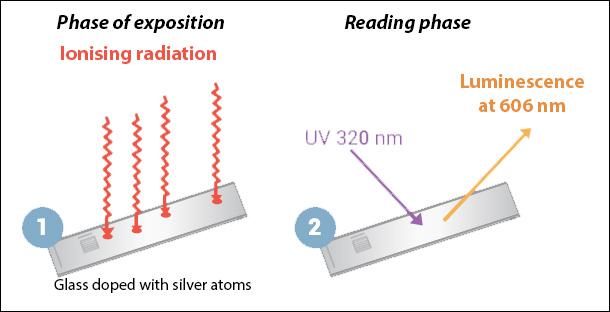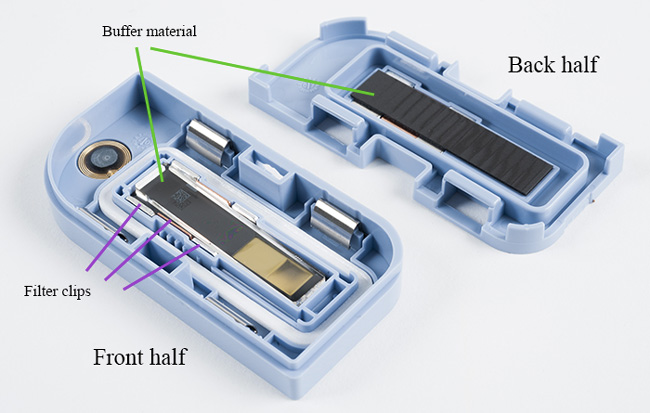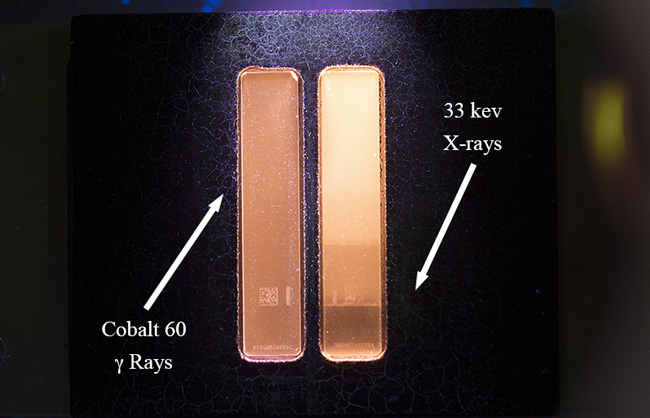Sensitive, robust and widely used dosimeters
These passive dosimeters use radiophotoluminescence (RPL) a property of some silver-doped glasses. During the exposure phase, ionizing X, gamma and beta radiations pull electrons from their atoms to be trapped in defects of the glass structure, silver ions present in the vitreous material.

IRSN RPL dosimeters
IRSN’s radiophotoluminescent portable dosimeters now replace photographic dosimeters. They are light (12 g) and relatively thin (8 mm). Inside they have a silver-doped glass plate for detection. Reading zones associated with absorbent screens make it possible to differentiate the radiations.
© IRSN
During the reading phase, the glass is illuminated with ultraviolet light to measure the exposure. The electrons trapped in silver atoms are excited and produce by desexcitation a characteristic orange luminescence. The intensity of the luminescence is proportional to the number of silver-trapped electrons, and its measurement therefore makes it possible to estimate the dose received. It is the arrival on the market of precise UV lasers which made it possible to develop this technique.
Reading is not destructive, it can be replayed multiple times without loss of information. The irradiated glass plate is reset by heating. If not, in a very marginal way, the dosimeter can continue to be used after reading, the doses accumulating: it can then be used as an personal integrating dosimeter. Outside periods of use, or for archiving, it is necessary to store the dosimeter with protection from radiation.

Principle of a RPL dosimeter
The dosimeter consists of a glass plate doped with silver atoms. When exposed to ionizing radiation (left) electrons are trapped in an excited level of these atoms. After exposure, during reading, the glass plate is subjected to an 330 nm wavelength ultraviolet radiation which causes the desexcitation of trapped electrons generating the emission of a light (luminescence) of 606 nm wavelength. The « luminescence » measurement provides the exposure received by the glass plate.
© IRSN
The design of IRSN dosimeters, which contain a RPL glass plate, allows to obtain different responses depending on the energy of the beta, X, or gamma radiation they receive. Indeed, the addition of small plastic or metallic screens (aluminum, copper, tin) around the plate makes it possible to define different measuring parts along the glass length of the blade.
The luminescence observed on irradiated glasses varies according to the attenuation of the radiation due to the screen effect of these interposed filters. There are thus several measurement available allowing to discriminate the type of radiation.

Inside of an individual RPL dosimeter
The figure shows the two anterior and posterior parts of a dosimeter. The glass plate is inserted between two layers of buffer material for protection. On the front half, one can see the three small metal screens acting as filters.
© IRSN
RPL dosimeters are very sensitive. Their threshold is 0.05 mSv (50 microsieverts)
Having replaced individual photographic dosimeters or dosifilms, IRSN’s passive RPL dosimeter is widely used in France with 1,200,000 annual analyzes.

Discriminating radiations with screens
On the right, glass plate irradiated by very penetrating Coblat-60 gamma, with energy higher than 1 MeV. Irradiation appears to be uniform. On the left, plate irradiated by low energy 33 keV X-rays, not very penetrating and partially absorbed by filters placed as screens.
© IRSN
in addition to individual RPL dosimeters, IRSN offers room and workstation dosimeters.
A room dosimeter is a dedicated passive dosimeter designed for measuring the ambient dose in work areas. It must be placed in a fixed position (against a wall for example). It allows the competent person in radioprotection (PCR), to perform internal environmental controls.
A workstation studies dosimeter is designed to perform preliminary dosimetric studies to accurately define the level of exposure of workers to ionizing radiation when new workstations are considered. Highly sensitive (no subtraction of background noise) the results are provided from the first microsievert measured.
Other articles on the subject « Dosimetry »
Passive Dosimeters
Portable dosimeters for monitoring of exposed people Dosimeters called passive are dosimeters tha[...]
OSL Dosimeters
Dosimetry by « Optically stimulated luminescence » The active element of an OSL detector i[...]
TLD Dosimeters
Exploit thermoluminescence for dosimetry The energy provided by ionizing radiation may cause defe[...]
Active Dosimeters
For real-time monitoring of workers exposed to radiation Active dosimeters are in fact ele[...]